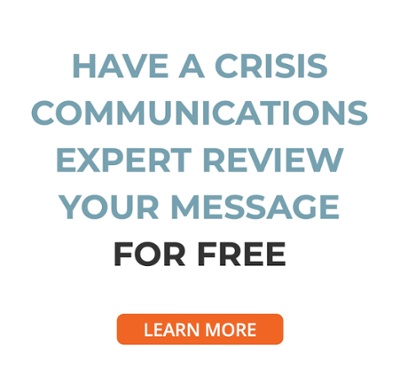Key Aspects of a Crisis Communications Strategy
1. Identify Stakeholders: First and foremost, your communications strategy should identify your stakeholder groups. Think about anyone that would be impacted in some way if your normal business operations changed, shifted focus or shut down—or who you would want to tell if you’re maintaining business as usual.
EXAMPLE:
A resort company identified employees, general managers, guests, homeowners, homeowner associations, board of directors and investors as their stakeholders.
2. Build Scenarios: Second, your communications strategy should outline the many possible scenarios that could pan out as the crisis unfolds. Whether it is a global pandemic, a natural disaster or other event with economic impacts, it stands to reason that the current state may not be current for long. It’s important to understand the various situations you could experience in the future.
EXAMPLE:
Retail companies should consider several possible states of business that could result from events outside of their control: full service, normal customer service but reduced production and shipping, normal customer service with no production or shipping due to workforce reductions, normal customer service but delayed production and shipping due to supply chain downstream impacts, and a complete shut down.
Here are 25 scenarios that we’ve built out for our clients facing COVID-19 changes that you might want to consider:
1. Employees have to start working from home
2. An employee gets sick
3. A customer (who has had contact with your office building/facility or an employee) gets sick
4. You want to remind employees about existing benefits and deliver resources
5. You’re offering employees additional benefits
6. You need to postpone an event
7. You need to roll out different internal or external processes
8. Employee layoffs or furloughs
9. Production and shipping operations are decreasing or shutting down, so orders will be delayed
10. A supplier is shutting down operations, which will impact some or all of your operations
11. A facility is closing and temporarily won’t be accepting returns
12. Certain services are being suspended, or service is delayed
13. You are offering a new service to help customers deal with the crisis
14. You are offering a promotion to boost sales during the crisis (Reminder: Be sensitive to the situation at hand. Don't exploit—or it could backfire)
15. You are taking extra precautions to clean and sanitize
16. Hours are changing
17. Future orders will be delayed
18. A stay at home order is issued in your city or state
19. Determined essential business, and some employees need to continue to go into the office
20. Determined essential business, but you’re still closing the office
21. You need to close your business (non-essential designation)
22. You want to thank your employees
23. Employees are lacking motivation or morale is low, culture is struggling
24. Employees are overwhelmed
25. Your cash flow or finances have taken a hit
3. Determine Key Messaging: For each of the above scenarios, you will have key messages that would need to go out to the impacted stakeholders. Create a bulleted lists of these points, and refer to them in step 4 when you craft your deliverables.
EXAMPLE:
If a retail company determines that customer service and corporate employees will be working from home, and that production and shipping operations will be reduced or schedules will be adjusted, they’ll need to communicate that with employees—and potentially with customers.
The company would want to ensure the following points are in their employee communication:
- The company’s top priority is the health and safety of its employees and customers ("We’re following all guidance from public health officials on cleaning and sanitation practices")
- The move-forward plan for employees: working from home for all employees where possible; staggered schedules for production and shipping employees to limit contact; reducing overall hours
- Fluid situation, committed to being agile as there are new developments ("We will keep you informed if anything changes")
- Reminder about benefits and resources that may be helpful during a health crisis
- Heartfelt thank you for their service to the company
For customers, they may want to include the following:
- The company’s top priority is the health and safety of its employees and customers ("We’re following all guidance from public health officials on cleaning and sanitation practices")
- Customer service: our employees are working from home, but still available to provide the same high-quality service as always
- Production and shipping: you may experience a delay of one week, as we have adjusted our operations schedule for the safety of our employees
- Heartfelt thank you for their business: reminder that the company’s mission and value proposition have not changed; they look forward to continuing their relationship with the customer
With bulleted lists like these, it will be easy once you dive into writing the communications, as you’ll have a checklist of what each deliverable should cover.
4. Develop Communications Strategy: With the stakeholders and scenarios in mind, you can start mapping out the deliverables—what communications will you need to speak to your stakeholder groups if each scenario played out?
Here are some ideas to get you started:
- Internal communications
- Company intranet/Slack channels/collaboration tool updates
- Internal FAQs
- Customer updates
- Customer FAQs
- Talking Points
- Chat responses
- Updated templates
- Website postings
- Social media postings
- Investor updates
- Board updates
Here are some free examples that may be helpful:
Scenario: Employee furloughs
- Manager presentation with talking points and employee resources
- Employee furlough FAQs
- Employee furlough letter
- Customer update (include the impact)
- Investor/board update (include the why, what it means for finances, and how you’re managing the situation)
Scenario: You want to remind employees about existing benefits and deliver resources
- Employee benefits email (links to appropriate brochures or websites to access more info)
- Internal intranet posting (internal resource center)
Scenario: Determined essential business and some employees need to continue to go into the office
- Employee email
- Letter for employees going into office
- Website posting - still open
- Customer communication (impacts to their service, if any)
It may seem overwhelming, but Craft Impact has a process that we’ve used for the last eight years for assisting our customers with strategic communications to support organizational change. We learn your business, determine the applicable scenarios, evaluate the impacted audiences, develop key messaging and craft compelling communications. That way you can focus on the health and safety of your people and your business.
If you’d like a free strategy session, feel free to reach out. Or, for more helpful resources in crisis, subscribe to our newsletter in the form below.



